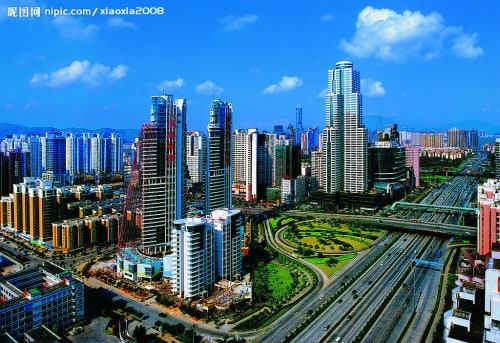
Shenzhen is located at the southern tip of Mainland China and neighbors Hong Kong. The city, which covers an area of 1,953 square kilometers, has about 14 million permanent residents.
As the brainchild of Deng Xiaoping, Shenzhen became China’s first special economic zone in 1980. Since then, it has been a touchstone for the reform and opening policy in China.
In less than 30 years, Shenzhen, a tiny fishing town of 30,000 people in 1979, has grown into a modern metropolis with GDP of $120 billion, 60% as that of Hong Kong. Now, Shenzhen is in the top ranks among mainland Chinese cities in terms of comprehensive economic power.
Shenzhen and Hong Kong have very close business, trade and social links. In 1980s, Hong Kong began to transfer the manufacturing industry across the border to Shenzhen, thus forming a featured cooperation relationship of “store in front and factory behind”. With gradual economic interdependence, the two cities are making effort on building an integrated international metropolis. According to a preliminary study by China Development Institute (CDI), up to 2020, GDP of SZ-HK metropolis will reach to $1trillion, and the total stock market value will amount to $10 trillion.
As one of China’s top three financial centers together with Shanghai and Beijing, the total assets of Shenzhen financial sector had reached $490 billion by June 2009, which far exceeded the total banking assets of UAE ($ 422 billion). With 63,000 employees, financial sector contributes $17 billion, accounting for 14% of Shenzhen’s GDP. As a matter of fact.
Shenzhen has the advantages in developing finance industry. It is estimated that Shenzhen handles over 40% of Chinese private-equity and wealth-management business. After the signing of Memorandum of Financial Cooperation between SZ- HK, more and more companies moved their headquarters from Hong Kong to Shenzhen. Shenzhen is also the home to some of China’s most successful financial institutions. China Merchants Bank, one of the largest banks in China, has its headquarters in Shenzhen. Shenzhen City Commercial Bank, Ping An Insurance and Wal-Mart China are also based in the city.
As a young city, Shenzhen’s reputation and influence are less competitive than that of Beijing and Shanghai. Yet, with rapid development of its economy, especially the financial sector, Shenzhen is catching up. According to two of the latest Global Financial Centers Index (GFCI) reports, Shenzhen ranks top 10 globally and No.1 in Mainland China. This shows that the dynamic development of Shenzhen Financial Center has attracted more and more attention.
Shenzhen’s achievement on the financial infrastructures relies on the convenience of international air links and telecommunications networks. The city is the world’s fourth busiest container port, China’s fourth busiest airport. Besides, the business costs are comparatively low. In 2009, the annual rent of office building in downtown is $38 per square foot, much lower than $143 in Hong Kong and $60 in Shanghai, ranking No.95 among 116 business areas in 47 countries of the world.
As a city of migrants, Shenzhen is open-minded, tolerant and innovative. It is an ideal place for domestic and international talent to start businesses. More and more talents from outside of China hold senior positions in local banks, security firms and insurance companies. English is used as a working language at business meetings, especially meetings of listed companies. Up to now, almost all of small and medium HK banks and 30 foreign banks have opened branches in Shenzhen, including HSBC, Standard Chartered Bank, and Citibank. 181 out of the Fortune 500 have invested in Shenzhen via FDI. The accumulated FDI amounted to $30 billion during the last decade, which is three times larger than that of Vietnam during the past three years. Shenzhen is also an innovative city with one third of PCT international patent applications in Mainland China.
Shenzhen government attaches great importance to the financial sector. It set up the first stock exchange (SZSE) of Mainland China in 1991, with HK Exchange regulation as its main reference. By 2009, the market value of listed companies in SZSE was about $87 billion, the share transaction volume was over $2.77 trillion, ranking respectively No.16 and No. 6 in World Federation of Exchanges; the mutual funds manage total assets of $127 billion, taking up over 30% of the market share, ranking No.2 in Mainland China. Although SZSE is not the largest stock exchange in China, it is special and professional, with main market, SME market (geared to medium and small firms), and the Growth Enterprise Market included. The products of wealth management issued by merchant banks have developed very quickly. In recent years, the local government began to embark on various reforms to deregulate the financial sector step by step. For instance, it rearranged the firewall between banking and trading securities and insurances to facilitate customers’ access to financial services.
Although financial hubs have proliferated in the whole world, few of them can claim to be truly global; many members of the financial field hold the idea that only New York City and London deserve this title. According to the study of the City of London, Hong Kong will be the next global one, with the advantages of plenty of skilled people, ready access to capital, good infrastructure, attractive regulatory and tax environments, low level corruption, convenient location and free use of English. What’s more, Hong Kong is integrating with Mainland China. Plenty of Mainland companies raise funds in Hong Kong; and Shenzhen works as an important gateway for the investment flow from both sides. Shenzhen also has the largest population actively investing in HK stock market. In the coming 10 years, Shenzhen will pilot the opening-up of China’s financial sector, and cooperate with Hong Kong in building RMB Offshore Financial Center. Thanks to the close link between Hong Kong and Shenzhen, over 150 million people travel between the two cities every year. That’s why cross-border flow of RMB is very active. One-third RMB currency issued by the Central Bank is circling in the area. Shenzhen is hence to become a hub of RMB currency

